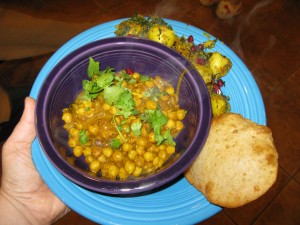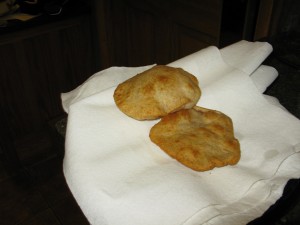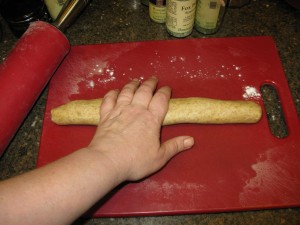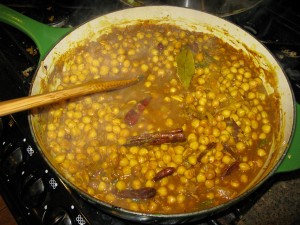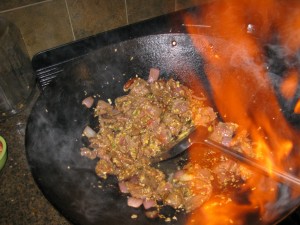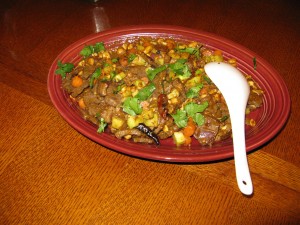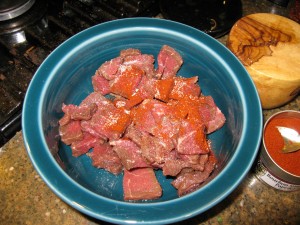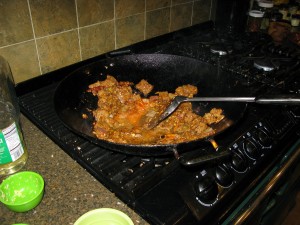Baby Gai Lan With Chicken and Chilies
They say all babies are cute.
And it’s mostly true.
But some babies aren’t just cute; they’re tasty.
Baby greens, for example, are tasty.
Baby gai lan goes beyond tasty into a realm I like to call, “Well, why haven’t I been eating this my entire life?”
That’s baby gai lan. It’s tiny–the stalks are, at their largest, as thick as my pinkie finger and abut as long as my middle finger at their longest. Most are smaller than that, though. And being tiny, its just darned cute.
And sweet–all babies are sweet, too, don’tcha know? Well, baby gai lan is really sweet–it has none of the bitterness that its adult brethren can be plagued with. It’s leaves are just as velvety when they are cooked as big gai lan, but the stalks are crisper, or rather, crisp in a different way. They crunch in a more iceberg lettucy-kind of way, instead of a more cabbagey kind of way like big gai lan.
So, I found some of this wonderful winter green at one of the Asian markets in Columbus, and even though I had already chosen Mamma gai lan to come home with me, I tossed the baby in the basket as well, because I’d never had it and I just had to know.
And now I know. And I’m letting you know, so we all will know, that if you see it in the market–buy it, run right home and cook it up and eat it. You’ll love it–that is–if you love greens.
I decided to make a very simple Cantonese-style stir fry out of the little gai lan–I wanted to showcase its flavor and texture without a lot of other stuff to get in the way. I added chicken for protein and textural contrast and fresh Thai chilies for color (I love the way scarlet pops when tossed in among forest and emerald greens) and a sparkle of heat.
For aromatics, I used a small red onion, two cloves of garlic, minced and a 1
1/2 inch cube of fresh ginger, peeled and minced.
And for condiments, a thin, light soy sauce, a bit of sugar, a tiny amount of Shao Hsing wine and some sesame oil. I used no broth to make a sauce–I wanted this to be a nearly dry dish, with what sauce there was clinging to the ingredients, making their own fresh flavors the star of the show.
It turned out to be superb–sometimes the old saying that, “less is more” really is true. And the Cantonese principles of cookery which is to enhance natural flavors without masking them is so often right. Sometimes food really does taste better the less you do to it.
One thing you will notice is that I add small amounts of soy sauce at three different points in the recipe and do the same with the wine twice. The reason for this is that I wanted each component of the dish to be seasoned carefully. So, the chicken marinates in the soy sauce and wine, then when it is cooking with the aromatics and chilies, soy sauce and wine are added again to marry the flavors of the aromatics with the chicken. The third and final addition of soy sauce comes when the gai lan goes into the wok, adding a bit of salt and umami goodness to the sweet greens.
Baby Gai Lan with Chicken and Chilies
Ingredients:
1/2-3/4 pound boneless skinless chicken breast, cut into thin 1″ long slices
1 teaspoon thin or light soy sauce
1/4 teaspoon raw sugar
1/2 tablespoon Shao Hsing wine
1 scant tablespoon cornstarch
2-3 tablespoons peanut or canola oil
1 small red onion, peeled and thinly sliced
3-5 fresh red Thai chilies, stemmed and cut in half lengthways, seeds scraped out
2 large garlic cloves, peeled and finely minced
1 1/2 inch cube fresh ginger, peeled and finely minced
1 1/2 teaspoons raw sugar
1 tablespoon light or thin soy sauce
1 tablespoon Shao Hsing wine
1/2 pound baby gai lan, well washed and dried
1-2 teaspoons light or thin soy sauce
1/2 teaspoon toasted sesame oil
Method:
Toss the chicken with the first measures of soy sauce, wine, sugar and cornstarch. Allow to marinate for about twenty minutes, while you prep the vegetables.
Heat your wok on high heat until a thin swirl of smoke rises from the hot metal. Add the peanut or canola oil, and heat for another 30-45 seconds, or until the oil shimmers and ripples slightly from the heat.
Toss in the onion slices, and stir fry vigorously until they soften and begin to take on a golden tone. Add in the chilies and continue cooking, stirring constantly, until the onions are truly golden and the chilies have wrinkled a bit and darkened from the heat.
Add the chicken in one layer to the bottom of the wok–spread it so as much of it is in contact with the hot metal as possible. Sprinkle garlic, ginger and the second measure of sugar over the top of the chicken pieces and leave the meat undisturbed on the bottom of the wok until you smell it browning. Then, start stir frying, keeping the contents of the wok in constant motion.
Add the second measure of soy sauce and wine, and keep stir frying until most of the pink has gone from the chicken and has been replaced with golden brown and white. Add in the gai lan (make sure it is really dry, please) and finally add the third measure of soy sauce. Cook, stirring, until the leaves wilt nicely and the green color of both the leaves and stalks darken slightly.
Remove from heat and stir in the sesame oil.
Serve immediately with steamed rice. I prefer jasmine.
This recipe will feed two or three people, depending on their appetite.
Meatless Monday: Channa Bhatura
I know that I’ve already posted one recipe for bhatura, and a recipe for channa masala, but these are completely different versions which everyone in the family has decided we prefer.
The bhatura recipe is more authentic than the one I wrote about before–there is no yeast in it at all; instead it is leavened with a starter made from equal parts all purpose flour and yogurt. It is based on Yamuna Devi’s recipe from Lord Krishna’s Cuisine with the exception that I used Greek yogurt in the starter and substituted whole meal spelt flour for some of the all-purpose flour.
This version of bhatura is thinner-walled and flakier–more delicate than the yeast-raised version I posted previously. But the dough is no harder to work with, roll out or fry, so there is no reason not to try making it.
As for the channa–I think that there are about a thousand different ways to make channa masala. Probably more than a thousand–for every household or restaurant where it is eaten, it is cooked slightly differently. I based this version on the one they serve at Udipi Cafe in Columbus, Ohio, which is my favorite vegetarian restaurant ever, hands down.
Their version has no tomatoes in it, or very few, and is yellow with turmeric instead of red with tomatoes and paprika. It is redolent of cinnamon and fenugreek, and liberally flavored with toasted whole cumin seeds and black mustard seeds. Oh, and it is fiery with chilies both dried and fresh–I should have mentioned that. Mmm… chilies.
You will also note that I served a dry version of aloo methi with this meal. Some of the versions of aloo methi are damper than others–aloo methi tamatar is by its nature wetter, being that one of the main ingredients is tomatoes. I sometimes add yogurt and spinach to it, which makes it saucier. But I have found that the textural differences between a dry curry and a wet one, served with bread and yogurt is most pleasing.
Every piece of bread was eaten–and most of the channa and aloo as well. I have enough of them for a light lunch left over, but nothing else. That’s how I know that dinner was appreciated highly–very little of it was left. I suggest doubling the channa and the bhatura recipes if you have more than five or six people eating, especially if you want anything left to munch on for lunch.
Flaky Bhatura
Ingredients:
1/2 cup whole milk or 2% Greek yogurt
1/2 cup unbleached all purpose flour
1 cup unbleached all purpose flour
3/4 cup whole meal spelt flour (or chapati flour or whole wheat flour or white whole wheat flour or kamut, take your pick)
1/2 teaspoon salt
1 teaspoon raw sugar or honey
1/2 teaspoon baking powder
3 tablespoons melted ghee or butter
about 1/4 cup warm water–use more or less as needed
canola or other vegetable oil for deep frying
Method:
First, the night before you want bhatura, make the starter–take your yogurt out of the refrigerator and let it come to room temperature. Then, preheat your oven to about 100 degrees F. by putting it on the lowest heat setting and turning it off just as it reaches that setting. Open the oven door, and place an oven thermometer on the rack, and when the temperature dips to 100 degrees F, close the door and keep it closed.
Stir the 1/2 cup of all purpose flour into the warmed yogurt, until a smooth paste is formed. Cover lightly with a warm, damp towel or plastic wrap and set inside the prepared oven. Leave the starter undisturbed for eight or ten hours or so.
Make the dough–put all the dry ingredients into a large bowl and stir to mix it well. Add the starter and the melted ghee, and the honey if you used it instead of raw sugar. Rub your hands with oil or ghee (ghee is really good for your skin, btw–I used ghee when making the bread yesterday to oil my hands and today they are amazingly soft and silky. On the other hand, it is pretty expensive as hand cream……) and start mixing the dough with your hands. Add as much water as is needed to make a smooth, reasonably stiff, pliable dough.
Knead it for eight to ten minutes or until the dough is springy–a fingerprint pushed into it will start springing back almost immediately when you have kneaded it enough.
Gather dough into a ball, rub the outside with ghee or oil, and put into a small bowl, cover with plastic wrap and let it rest for at least 1/2 hour, or as long as 3 hours.
When you are ready to roll out the dough, cut the ball into two equal pieces and roll one into a thick log about 1 1/2 inches in diameter.
Cut this log into seven equal pieces, and roll each of those into smooth balls. Flatten each one with your hand into a disk about 2 inches in diameter.
Dust your surface very lightly with flour, place a disk into the flour, turn over and shake off the excess. Using a rolling pin, roll evenly into a thin 4 inch diameter circle, and set aside until all the other disks are rolled. Do the same with the other half of the dough–roll into a log, cut it into seven equal pieces, roll each into a smooth ball, flatten into disks and then roll out into 4 inch diameter circles. Lay them on a plate and cover with a very lightly dampened towel.
Heat your cooking oil in a wok, karahi or deep saucepan over medium high heat. Test the oil with a dry bamboo chopstick by simply placing it into the oil. If tiny bubbles immediately start traveling up the chopstick tip, the oil is ready.
When the oil is ready, carefully slip a single dough disk into the oil so that it goes in flat, not folded. It will sink to the bottom, and immediately the oil will bubble and foam. After a few seconds, the dough will start to rise at the top. Using a slotted spoon or a mesh skimmer, gently hold the dough under the surface of the oil so that it puffs up into a little bready balloon.
As soon as the bhatura puffs up, hook your spoon or skimmer under it and gently flip it over. Let it brown very gently on the other side–not too much–it will only take a few seconds–then take out the bhatura with your spoon/skimmer and let it drain on layers of paper towels.
Serve immediately, before the bhatura cool and deflate.
Now this means that you should have everything ready–channa, potatoes and garnishes–and -THEN- start frying the bhatura. You can either serve each bhatura as it comes out of the oil to each diner, or you can fry half of the dough–seven portions–serve that, and turn the heat off on your oil. Sit down and eat that, and then, when (note I do not say, “if,” but “when”) your family wants seconds, go back, turn the heat back on under the oil, test with a chopstick and then start cooking the second batch.
These breads cook very quickly–in a matter of seconds, really. I haven’t timed them, but I suspect that they each cook in under a minute. That is indeed, how fast they go.
They get eaten nearly as quickly.
Channa Masala II
Ingredients:
1 pound dried chickpeas
1 teaspoon ground turmeric
1 teaspoon smoked paprika
1/4 teaspoon ground cinnamon
2 bay leaves
2-3 tablespoons ghee
1 large onion, thinly sliced
1 teaspoon salt
5-6 dried thin hot chilies
1 large cinnamon stick
5 whole cloves
8 whole green cardamom pods
1 teaspoon black mustard seeds
2 fresh long, thin green chilies, thinly sliced on the diagonal
4 cloves garlic, peeled and minced very finely
1″ cube fresh ginger, peeled and minced very finely
1 1/2 teaspoons cumin seeds
1/4 teaspoon black peppercorns
1 teaspoon fenugreek seeds
2 cloves
1/2 teaspoon coriander seeds
1 teaspoon ground turmeric
1/2 teaspoon smoked paprika
water as needed
2 tablespoons pappulu podi
1 1/2 teaspoons tamarind concentrate
salt to taste
roughly chopped cilantro leaves for garnish
Method:
Sort through the chickpeas and remove any suspicious looking (shriveled, black or moldy) beans and any small stones or dirt clods. Rinse well with cold water, then put into a large bowl. Cover well with warm water–the water should stand about an inch over the top of the beans–and cover the bowl and let stand overnight.
Drain the remaining water from the beans and discard. Put beans into pressure cooker (or regular large pot) and add water to cover by two inches, one of the bay leaves, the teaspoon of turmeric powder and the powdered cinnamon. Bring to a boil, put the lid on, lock it and bring to full pressure. Turn down the heat, cook on full pressure for fifteen minutes. Then, take the cooker off the heat and allow it to depressurize on its own, gradually. Open the cooker and check the texture of the beans–they should be tender and absolutely done with no crunchy bits. If it is not done, bring to a boil, put on the lid, bring up to pressure, lower heat and cook for another five minutes, then remove from heat and allow the pressure to lower naturally off heat and check again–they should be done at this time.
If you do not have a pressure cooker, put the directed ingredients into a regular deep, large pot, and simmer until the beans are done–about an hour.
Drain the beans, reserving about a cup of the liquid.
Melt ghee in a heavy-bottomed deep frying or braising pan. Add onions, sprinkle with salt and the second bay leaf, and cook, stirring, until the onions turn light golden. Add the whole spices and dried chilies save for the mustard seed at this time, and continue cooking and stirring until the onions turn deep golden brown. Add the mustard seed and the fresh chilies, and cook stirring until the mustard seeds pop. Add the garlic and ginger and lower heat, still stirring, though not as constantly.
Grind the remaining whole spices together and add to the pan with the turmeric and the paprika, and cook, stirring until the onions are a deep reddish brown and everything is fragrant. Add the chickpeas and enough of the reserved cooking water to the pan to deglaze the pan. Scrape all the browned bits up from the bottom of the pan and turn the heat down so it can simmer. Allow to simmer uncovered for 1/2 hour to 45 minutes. Add water as needed to keep the curry moist.
Thicken the curry with the pappulu podi and add the tamarind concentrate. Simmer for five more minutes and add salt as needed to taste.
Remove from heat and sprinkle the cilantro over the channa. Serve immediately with bhatura.
Fire in the Wok
Finally!
I succeeded at getting a good shot of flames rising from the wok while cooking.
And, I thought that since this photograph looked cool enough to share, I should probably write a bit about how and why to safely set fire to food in your wok.
First, let’s talk about why you’d want to set your food on fire in the first place.
Well, because it makes it taste good, of course. It flash caramelizes sugars and sears any ingredient that is in the wok. It also burns off the alcohol in the liquor or wine and leaves behind just the flavoring essence.
It also looks really cool.
But, it can be dangerous.
So, let’s look at a few simple rules to follow when using distilled liquor to flame a dish in a wok.
1. Never pour liquor directly from the bottle into the wok or pan while it is on the fire. Distilled liquors have too much alcohol in them for this to be safe–the alcohol vapors can ignite while you are pouring from the bottle. The flames can then follow the stream of liquor up into the bottle and ignite the rest of the alcohol. Which can cause an explosion. No, really, it can. It happened at the culinary school I attended. So, just don’t do it. Always pour the amount you are going to use into a pitcher or small container with a wide mouth.
2. When you pour the alcohol, do it quickly, and don’t lean close to the wok while you do it. You would think this would be a self-evident bit of common sense, but no–plenty of folks when they ignite something in their wok the first time lean in to see what will happen next. Well, if you lean in, what happens next is your eyebrows get singed. Oh, and if you have long hair like I do, tie it back before playing arsonist in the kitchen. The reasons for this should be obvious.
3. If your flame isn’t high enough to ignite the alcohol directly, you can gently tip one edge of the wok away from yourself and toward the burner slightly so that the flame catches and tongues of fire leap up. At this point, set the wok back level on the burner and gently stir the contents of the wok with your wok shovel in order to spread abut the flavor enhancing effects of the liquor.
4. Always have your exhaust fan on before you set things on fire in your wok. If you don’t have an exhaust fan or vent hood, consider NOT setting stuff on fire in the wok. Also, have your wok lid handy to smother the flames if necessary, and keep a box of baking soda nearby to use to smother flames. Also, please know exactly where your fire extinguisher is, you know, just in case. Do NOT use water to douse any flames.
5. Finally, keep all wayward children, animals, boisterous family members and naturally nervous people far from the stove when you go to set fire to anything in your wok. In fact, I highly suggest you send all such folk out of the kitchen before you do it, otherwise, you will have to listen to the nervous ones kvetch about your “reckless cooking” for hours, and it will just might ruin whatever dish you cooked so beautifully.
Whiskey Smoked Kung Pao Beef
One night last month, I got it in my head to make Kung Pao Beef.
Which is a good thing, normally, but you see, when I went to the pantry, I realized that not only did I not have any Shao Hsing wine, I had no dry sherry either. Horrors! Bad, bad, bad chef, bad cook, bad blogger, bad, bad, bad.
But, I really wanted Kung Pao Beef. So, I went digging around to see what I -did- have in the pantry of an alcoholic nature. Zak has tequila about so he can make a margarita now and then when he gets a hankering for limey, salty agave goodness. But, the thought of tequila mixed into Kung Pao did not thrill me.
There was red wine in the pantry, but uh, no, I passed that right up. Rum, ditto. Benedictine–I thought seriously about that one, but I decided that the distinctly medicinal flavor of the herbal liquor would clash horribly with chilies, peanuts and soy sauce. In fact, I can feel my tongue shudder at the thought even as I type these words. No Irish Cream. I couldn’t bring myself to use any of the Grey Goose vodka that is stashed in the freezer for medicinal purposes, but what I did find was a mostly full bottle of Jameson Irish Whiskey, which is my drink of choice if I am to drink. (Because of my medication, I can’t really enjoy alcohol, so I content myself to a shot of good whiskey every other month or so.)
And that bottle of whiskey looked mighty lonely and I began to think.
There was a thought niggling at the back of my head that in one of my older Chinese cookbooks in my collection of out of print goodies upstairs I had read that sometimes it was acceptable to use whiskey as a substitute for Shao Hsing wine, though the author wasn’t really hot about the idea herself. And as I thought, I also remembered reading about a chef in a Hong Kong restaurant that used whiskey to flame a special dish–some chicken preparation as I recall. And of course, I had heard of whiskey chicken soup, to be consumed after the birth of a child.
(It turns out that the book I read that bit about substituting whiskey for rice wine is Secrets of Chinese Cooking by Tsuifeng and Hsiangju Lin, the wife and daughter of influential Chinese author Lin Yutang. The book was published in 1960, and in its day, helped to popularize Chinese cookery in the United States. It is still filled with good information and lively writing today. If you can find a copy, pick one up, it’s well worth reading.)
So, I picked up the bottle opened it and sniffed it. The characteristically flowery scent of Irish whiskey filled my nostrils and I thought about it and decided, “I think it will work.”
And so, I poured a shot and a half into a glass and went on preparing my ingredients.
I noted avidly that when I tossed the whiskey into the wok, I didn’t have to tip the rim of the wok into the fire to get it to flame–the distilled spirits caught fire immediately and flared to life in a dancing tongues of blue and gold writhing like insubstantial serpents over the beef.
And when we sat down to eat it, Zak noticed the difference immediately–it was smokier in flavor and aroma than my usual recipe, and somehow the flavors of the beef, vegetables and peanuts seemed clearer and stronger. He, Kat and I liked it even better than the way I usually made Kung Pao, but it still wasn’t perfect, so my mind went to work on how to improve the flavor profile of the dish even more.
Which is how this recipe was born. It started out with the substitution of one ingredient for another, and ended up with the addition of a completely different ingredient that isn’t Chinese at all, and the substitution of one version of soybean paste for another, such that while I still call this Kung Pao Beef–and it still tastes unmistakably both Chinese and Kung Paoish, it doesn’t taste like any other version of the dish I have ever eaten anywhere.
When I made it again with all of these changes and took photographs of the cooking process to share it here with you, I decided to use Morganna, who is still working as a line cook at one of the fine dining restaurants here in town and who is developing into quite the chef herself, as a guinea pig. Well, actually, she showed up at the door unexpectedly and I popped a piece of the beef in her mouth as I was putting away the leftovers before I even really said hi to her. Even cold, she chewed it up with a blissful expression and then said, “Best. Kung. Pao. Ever.”
So, I am thinking, that while it may not be traditional at all, and it may technically be a fusion dish–this Kung Pao is still recognizably Kung Pao, so a new name wasn’t necessary–just two qualifiers–“whiskey” and “smoked.”
What are the other changes I made in the dish?
Well, you might think I’m a bit off my nut, but I marinated the beef in not just some sugar, cornstarch, soy sauce and whiskey–I also added about a teaspoon of smoked paprika. Specifically, paprika that was smoked over old bourbon barrels by a Kentucky company called Bourbon Barrel Foods. Their smoked paprika is rich, deep red and amazingly haunting in flavor. Very smokey, but sweet and somewhat floral as well.
And, instead of the little bit of hoisin sauce that I usually add to the wok near the end of cooking, I substituted ground soybean sauce–the brown kind, not the yellow. I also used both dried tien tsin chilies and fresh cayenne chilies to add heat to the already smokey dish. I cut back on the sugar a bit and tweaked the amount of vinegar in the sauce as well, so that when I scraped the steaming contents of the wok onto the serving platter, each bit of beef and vegetable and peanut was just glazed with a shimmering reddish brown sauce, with very little left to pool on the plate below.
The only thing that frustrated me while making this version of Kung Pao was trying to catch an image of the flames in the wok with my camera while still tending to the stir frying. I think I lost my touch–I used to be able to stir-fry left handed while photographing right-handed and get some great action shots. Not so much anymore–I only got one shot of fire in the wok, and of course, it is after the flames had died down to a warm orange glow that is not nearly so dramatic as vibrant blue and gold!
But that’s okay. I can always try again the next time I cook it! And this time, I’ll be sure that Zak distracts Kat elsewhere–she wasn’t too thrilled by Mommy nonchalantly setting stuff on fire in the kitchen–I think she was rather put out by the entire idea.
Though, I must note, it didn’t stop her from eating plenty of the results of those flames when it was all over.
Whiskey Smoked Kung Pao Beef
Ingredients:
3/4 pound top round, cut into very thin (1/4″ thick) slices across the grain, and then into pieces 1″ square
1 tablespoon whiskey
1 teaspoon light soy sauce
1/2 teaspoon raw sugar
1 scant teaspoon smoked paprika
1 tablespoon cornstarch
3-4 tablespoons peanut or canola oil
1 small red onion, peeled and cut into 1/2″ dice, then separated into squares
5-10 dried tien tsin chilies
pinch of ground Sichuan peppercorns
3 cloves garlic minced
1 1/2″ cube ginger, peeled and minced
2 fresh cayenne chilies, cut into thin slices on the diagonal
1 ounce shot of whiskey
1 tablespoon dark soy sauce
1/2 cup carrots peeled and cut into 1/4″ thick rounds
3/4 cup broccoli stalk, peeled then cut into quarters lengthwise, then into 1/4″ thick wedges
1 teaspoon ground bean sauce
scant 1/4 cup chicken broth
2 teaspoons chiangking black rice vinegar
1/2 cup unsalted dry roasted peanuts
1/4 teaspoon sesame oil
cilantro leaves for garnish
Method:
Toss beef in a bowl with whiskey, soy sauce, sugar, paprika, and cornstarch and allow to marinate for twenty minutes while you prepare the rest of the ingredients.
Heat wok over high heat until a thin whisker of smoke swirls up from the surface and the smell of hot metal wafts to your nose. Add peanut or canola oil and allow to heat for another minute, or until the oil shimmers and ripples slightly on the bottom of the wok.
Immediately add the dried chilies and onions, and cook, stirring vigorously, until the onions brown slightly and the chilies darken. Add the beef, reserving any liquid marinade still in the bowl. Spread the beef out into a single layer over the surface of your wok and sprinkle the Sichuan peppercorns, garlic, ginger and cayenne chilies over the top of the meat. Leave the meat alone, undisturbed on the bottom of the wok to brown well for at least a minute. Then, stir fry for about another minute, stirring constantly, until the beef is seared with very little pink still showing.
Stand well back from the wok and toss the shot of whiskey in. If your flame is high enough, the dish will flame on its own. If not, you can quickly tip the wok slightly, dipping the rim toward the flame and it will catch fire.
Note: Please have the wok lid and baking soda ready to smother flames–NOT water– and be careful. AND, whatever you do–do not pour the whiskey directly from the bottle into the wok–freak accidents that involve alcohol vapors igniting the liquor in the bottle while you are holding it can and do happen. Also, please have your exhaust fan running and if you don’t have one of those–don’t flame stuff in your kitchen. And, please know where your fire extinguisher is. Now that I have terrified you and sounded like everyone’s nervous mother, we will continue the recipe.
After the flames die down–which they will do quickly–add the dark soy sauce, and toss the meat well. Then, add the carrots and cook, stirring for about a minute, then add the broccoli stalks. Then, stir in the ground bean sauce and use the chicken broth to deglaze the wok. Be sure to scape all the browned bits off the sides and bottom of the wok into the sauce–they are filled with flavor. Stir in the vinegar and peanuts, then bring the wok off the heat and stir in the sesame oil.
Scrape onto a heated platter and scatter cilantro leaves over the top for a garnish. Serve with steamed rice and if you have it, puer tea.
Reethika: Homestyle Indian Food Served With Love
I don’t do restaurant reviews. It just isn’t my bag, but now and then, I come across a restaurant that is just so special I have to tell everyone about it. So, while the following post is more of a personal story than a review, be assured that I want you to try the restaurant if you get a chance.
It all started six weeks or so ago, when Zak and I were in Columbus doing errands, we drove into one of the seemingly endless strip mall parking lots that dot Sawmill Road. Zak wanted to visit the tobacco shop in this shopping center, and I was just going along. But, as we walked, my Curry Sense went off.
Okay, let me explain Curry Sense. I don’t have Spidey Sense, because I haven’t been bitten by a radioactive spider, and would never go clambering around in a lycra bodysuit, even if I had. But I do have an unerring ability to be able to feel the proximity of a delicious curry. Even if it is out of sight and I can’t smell it, something subliminal prickles in my mind and causes me to look around my environment, and nine times out of ten, there is Indian food nearby.
And lo and behold–just down the way from the tobacconist’s was an Indian restaurant that hadn’t been there before. Of course, even though we had just eaten and we needed to leave town so we could drive back to Athens in time to pick Kat up from preschool, I glanced in. And saw, to my delight, a table full of Indian ladies in saris lunching happily next to another table filled with Indian folks. I knew then, without even getting a whiff of a curry leaf, that this was going to be a good restaurant.
See–I have never in my life been steered wrongly about any ethnic restaurant when I see a majority of its patrons are of the same ethnicity as the cuisine being served. When we were in San Francisco years and years ago, and were wandering around in Chinatown, when we got hungry, Zak and I looked for restaurants where everyone was Chinese-American. And if they were speaking Chinese, so much the better–and lo and behold–in each of those establishments, the food was out of this world amazing and we could order stuff that you seldom see on most American Chinese restaurant menus.
I judge Indian restaurants the same way, as well as Japanese and Thai, and I have never been led astray. Doesn’t matter where in the US we are, my system has always worked.
So, I nudged Zak, pointed the restaurant, which had a banner over their window reading, “Reethika,” out to him and he said, “Well, you have to come back to Columbus next week for your appointment, so your assignment is to scope the place out for us.”
And that is what I did.
Except, I hadn’t looked at the business hours so I was unaware that by the time I was out of my appointment, that the restaurant had closed up in order to prepare for the dinner hours. So, I showed up at the door, saw a couple of tables full of Indian folks eating, and I walked right in to immediately realize my mistake, for everyone looked up and blinked at me. I saw that these were the restaurant employees eating their midday meal, and the apologies bubbled up from me–because I know exactly how hungry restaurant staff are between lunch and dinner shifts and how tired they are of looking at people.
But as I started backpedaling, embarrassed, Mr. Reddy, one of the owners, stood up, and shook his head, motioning me to a table. “Sit, sit,” he said, “We have plenty.”
So, I sat, and was astonished at the absolute graciousness and genuine friendliness with which I was served by Mr. Reddy and his daughter for whom they had named the restaurant. They heated up and brought me some of everything from the buffet, which was a huge amount of food, and were very attentive to me, and asked how I liked the food, because the chef, Mrs. Reddy, who was seated at one of the tables with some of the employees, having her own lunch, spiced the dishes to their taste. Which meant the flavors were complex and fresh and redolent of curry leaves, cardamom, cinnamon and chilies.
Which is to say, the food was absolutely divine. The food is home-style non-vegetarian South Indian dishes, specifically in the style of Hyderabad. Completely different in flavor, aroma and style to the typical North Indian dishes found on most Indian restaurants in the US, the food made me nearly weep with joy.
Mrs. Reddy, who had been watching me off and on as I ate, asked me if I lived in Columbus, and I shook my head and said no, but that I came to the city every Tuesday for a standing appointment. She smiled broadly and said quite confidently, “Then we will see you every Tuesday.”
That wasn’t bravado talking–she was absolutely right. I have eaten lunch there nearly every Tuesday for the past month. I have yet to have a dish I have not liked. The rasam–a thin, peppery soup based on lentils and vegetables–is amazing, and never fails to clear my sinuses. Some of her curries are redolent of cardamom, so fragrant that I was nearly carried away on a cloud of sweetly spicy aroma. Others, like her “Green Chicken”, which I had today, are so complex and yet simple, it is hard to pin down exactly what is in them. (And for me, this is a rarity–I can nearly always untangle the intricate flavors of most dishes in any Indian restaurant. Not at Reethika.)
The chapati–they were the best I have ever eaten. They have a unique flavor that I can neither describe, nor put my finger on what it could be. The bread was brought out to me fresh and hot from the griddle and it was chewy and tender at the same time and fragrant with a toasty wheat flavor that was reminiscent of roasted almonds.
I stood up to pay, and Reethika shook her head and said, “But you haven’t had dessert yet, sit back down, I’ll bring it to you!”
And, even though I was stuffed to the gills with some of the best Indian food ever, I was presented with a warm bowl of kheer. Which was thicker and creamier than the kheer I am used to, but it was so good! Even though I thought I might burst, I scraped the bowl clean, and as I waddled up to the counter to pay, I thanked everyone profusely for their generosity and friendliness. I promised to come back the next Tuesday, this time before they closed and I did. And have returned every Tuesday (plus an extra Thursday with Zak) up to and including today.
Which brings us to the subject of today.
I showed up at ten minutes after eleven in the morning, just after they regularly open. The door was locked, but one of the smiling servers opened the door and said, “We are not opening for lunch today, but come in.”
And there were Mr. and Mrs. Reddy, waving me in. It seems that the steam table had refused to work that morning, so they couldn’t set up their buffet. But, they would not turn me away unfed–I was ushered to a seat, where a large bowl of rice was placed before me. As I waited, a string of little bowls of green chicken, rasam and egg curry were brought to me, as well as a cup of chai masala so that I could warm up. (It was beastly cold in Columbus–about twenty two degrees with ten and twenty mile an hour winds. Ugh.)
Mrs. Reddy came and asked how I liked everything, and I told her that her green chicken was superb, and that if it wouldn’t be considered to be rude, I’d have licked the bowl. She then promptly whisked away the empty bowl, refilled it with green chicken and sat it down before me and watched with satisfaction as I ate it gleefully. We chatted about rasam–she was happy to find that I knew what it was–apparently most Americans don’t–and I thanked her profusely for letting me come in for lunch even though they were closed, not once, but twice.
She smiled went back to the kitchen.
When I went to pay at the counter, they didn’t even charge for the full buffet, because, as they said, I had not eaten the full buffet. I left a generous tip.
I am still mightily impressed with the warmth and graciousness of the Reddy family at Reethika, and I suspect I always will be. They have treated me as a guest, as if I were in their home, not a restaurant, and that kind of care is rare these days. I appreciate it greatly, and want others to appreciate it, too.
And, of course, I want you to try Mrs. Reddy’s wonderful curries. Especially the green chicken.
So, I will end my “not really a restaurant review” post with the address and telephone number of Reethika in Columbus, though you can get the same information, including the hours they are open, by clicking on the link above.
Reethika Indian Restaurant
2661 Federated Blvd
Columbus OH 43017
614-659-0889
Powered by WordPress. Graphics by Zak Kramer.
Design update by Daniel Trout.
Entries and comments feeds.




